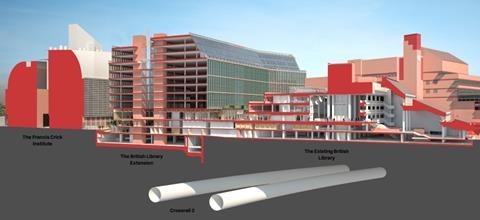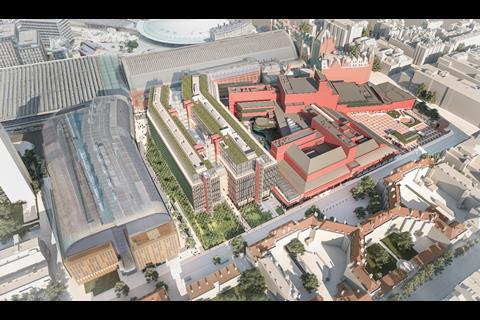Camden council passes controversial proposals with no votes against

RSHP’s highly controversial plans for an extension to the British Library were given the go ahead last night.
Camden council voted seven in favour with one abstention to approve the £400m plans for a 100,000sq m office and library block neighbouring Colin St John Wilson’s grade I-listed landmark.
The scheme will see demolition of buildings to the north of the main library, including the 2007 British Library Centre for Conservation, designed by Long & Kentish.
The replacement 12-storey building would contain just 10,000 sq m of library space, including a link to the main library and new headquarters for the Alan Turing Institute.
RSHP senior design partner Graham Stirk said the approval would see the site transformed into “the most open, creative, and innovative institution of its kind anywhere in the world”.
“The future vision of the British Library is made possible by a state-of-the-art life-science facility that creates a vibrant synergy between a major public institution and private sector applied sciences,” he said.
Stirk added the new building would dramatically increase the library’s public functions and make it the new heart of the Knowledge Quarter, a cluster of research institutes at King’s Cross.
John McElgunn, a senior partner at RSHP, said: “We are delighted that we were given the green light from Camden for the extension to the British Library on Monday 30 January 2023. This is RSHP’s most public building of our recent cultural projects and will truly transform the British Library experience.
“The creation of a new commercial lab-enabled space will advance the essential eco-system in the Knowledge Quarter and strengthen the research links between the Library, the Alan Turing Institute, and the Francis Crick Institute.
“The opening up of the site together with increased public accessibility will provide spaces to bring the Library, commercial occupiers and community together, increasing opportunities for local people. This is a unique opportunity for Camden and for the advancement of scientific research. “
The developers, a JV between Stanhope and Mitsui Fudosan, secured the site by agreeing a deal with Transport for London which will see them build 5,000 sq m of shafts and passageways descending seven storeys beneath the extension for Crossrail 2.
Stanhope chief executive David Camp said the scheme would provide significant areas of new public realm and much needed new space for the British Library.
> Also read: RSHP’s proposed British Library extension is like a bull in a china shop
> Also read: Architect slams RSHP’s British Library extension as “acoustic cover of Wilson’s high-tech power ballad”
Mitsui Fudosan UK chief executive Tomoo Nakamura said Camden’s decision “recognises the importance of this scheme both for local people and for users of – and visitors to – the British Library”.
“It also represents a great opportunity to contribute to the area’s economic success and to enable the delivery of key infrastructure,” he added.

The proposals will now go to the Greater London Authority for final sign-off. They had been recommended for approval by Camden’s planning officers prior to yesterday’s meeting despite concerns over the size of the building and the relatively small amount of library space.
The planning officers’ report admitted the scheme would cause some harm but argued this would be outweighed by its benefits.
Work for the mothballed Crossrail 2, which would be carried out in case the project is revived, will include the main civils and structural elements of the Euston St Pancras Station eastern shaft and passenger subway tunnel.
Others working on the project include QS Alinea, engineer Arup and landscape architect DSDHA.



















No comments yet